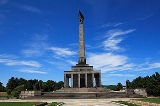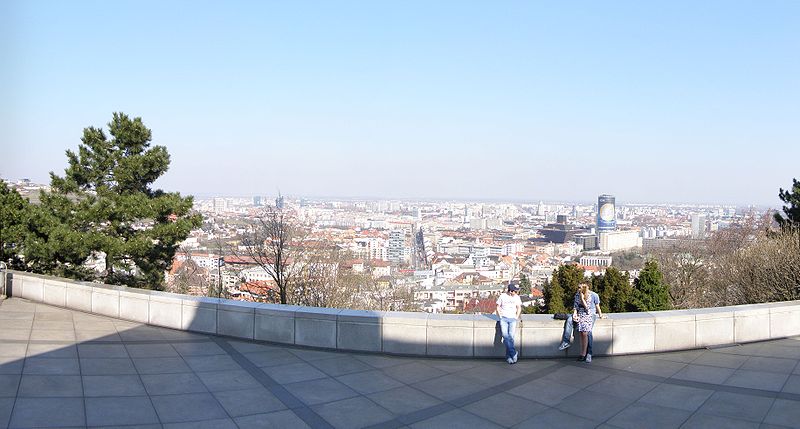
Slavín
Encyclopedia
- The Vyšehrad cemeteryVyšehrad cemeteryEstablished in 1869 on the grounds of Vyšehrad Castle in Prague, Czech Republic, the Vyšehrad cemetery is the final resting place of many composers, artists, sculptors, writers, and those from the world of science and politics...
in Prague is also known as Slavín
Slavín in Bratislava
Bratislava
Bratislava is the capital of Slovakia and, with a population of about 431,000, also the country's largest city. Bratislava is in southwestern Slovakia on both banks of the Danube River. Bordering Austria and Hungary, it is the only national capital that borders two independent countries.Bratislava...
, Slovakia
Slovakia
The Slovak Republic is a landlocked state in Central Europe. It has a population of over five million and an area of about . Slovakia is bordered by the Czech Republic and Austria to the west, Poland to the north, Ukraine to the east and Hungary to the south...
(formerly in Czechoslovakia
Czechoslovakia
Czechoslovakia or Czecho-Slovakia was a sovereign state in Central Europe which existed from October 1918, when it declared its independence from the Austro-Hungarian Empire, until 1992...
), is a memorial
War memorial
A war memorial is a building, monument, statue or other edifice to celebrate a war or victory, or to commemorate those who died or were injured in war.-Historic usage:...
monument and cemetery
Cemetery
A cemetery is a place in which dead bodies and cremated remains are buried. The term "cemetery" implies that the land is specifically designated as a burying ground. Cemeteries in the Western world are where the final ceremonies of death are observed...
for Soviet Army
Soviet Army
The Soviet Army is the name given to the main part of the Armed Forces of the Soviet Union between 1946 and 1992. Previously, it had been known as the Red Army. Informally, Армия referred to all the MOD armed forces, except, in some cases, the Soviet Navy.This article covers the Soviet Ground...
soldiers who fell during World War II
World War II
World War II, or the Second World War , was a global conflict lasting from 1939 to 1945, involving most of the world's nations—including all of the great powers—eventually forming two opposing military alliances: the Allies and the Axis...
while liberating the city of Bratislava in April 1945 from the occupying German Wehrmacht
Wehrmacht
The Wehrmacht – from , to defend and , the might/power) were the unified armed forces of Nazi Germany from 1935 to 1945. It consisted of the Heer , the Kriegsmarine and the Luftwaffe .-Origin and use of the term:...
units and the remaining Slovak troops who supported the Tiso government. It is situated on a hill amidst a rich villa quarter of the capital and embassy residences close to the centre of Bratislava.
This grandiose monument and cemetery of soldiers of the Soviet Army who were killed in deliverance of Bratislava during the Second World War has been designated the National Cultural Monument. On top of the 39.1 metre high pylon stands an 11 metre high sculpture of a soldier by A. Trizuljak. The bronze caisson door of the memorial auditorium is decorated with reliefs by R. Pribiš.
The monument was dedicated in 1960 on the occasion of the 15th anniversary of the deliverance of the city by the Soviet army. In the cemetery are buried 6,845 soldiers. Exactly 63 years after the war, this monument represents the city Lucenec as one of the important cities by acquirement of freedom and the peace. On its walls are listed cities with dates of their deliverance.
It was constructed between 1957 and 1960 on the site of a field cemetery, and opened on April 3, 1960 on the occasion of the 15th anniversary of the city's liberation. The monument was constructed similar in kind to the Palace of Culture and Science in Stalinist architectural
Stalinist architecture
Stalinist architecture , also referred to as Stalinist Gothic, or Socialist Classicism, is a term given to architecture of the Soviet Union between 1933, when Boris Iofan's draft for Palace of the Soviets was officially approved, and 1955, when Nikita Khrushchev condemned "excesses" of the past...
style. In 1961 it was declared a National Cultural Monument. Its designer was Ján Svetlík.
The site consists of:
- A solemn staircase
- A cemetery with graves (6 mass graves, 278 individual graves) of 6,845 Soviet soldiers who fell while liberating Bratislava
- The central solemn hall with various statues, inscriptions, and a symbolic sarcophagusSarcophagusA sarcophagus is a funeral receptacle for a corpse, most commonly carved or cut from stone. The word "sarcophagus" comes from the Greek σαρξ sarx meaning "flesh", and φαγειν phagein meaning "to eat", hence sarkophagus means "flesh-eating"; from the phrase lithos sarkophagos...
made of white marbleMarbleMarble is a metamorphic rock composed of recrystallized carbonate minerals, most commonly calcite or dolomite.Geologists use the term "marble" to refer to metamorphosed limestone; however stonemasons use the term more broadly to encompass unmetamorphosed limestone.Marble is commonly used for...
. It also features a 39.5 m high obeliskObeliskAn obelisk is a tall, four-sided, narrow tapering monument which ends in a pyramid-like shape at the top, and is said to resemble a petrified ray of the sun-disk. A pair of obelisks usually stood in front of a pylon...
topped with a statue of a Soviet soldier, and on the outside walls are inscriptions of the dates of liberation of various places in Slovakia during 1944–45.
Other facts about Slavín:
- This monument is situated in Malé Karpaty and it is very often attended because of its beautiful view.
- In the area of Slavín are also more statues of Slovak famous artists, such as Jan Kulich, Tibor Bártfay and Jozef Kostka.
- In 2005, Vladimir Putin, Russian president, visited it during his meeting with G. W. Bush in Bratislava.
- There is day of Bratislava's liberation on 4 April, when people and president show their honor to fallen Soviet soldiers.


